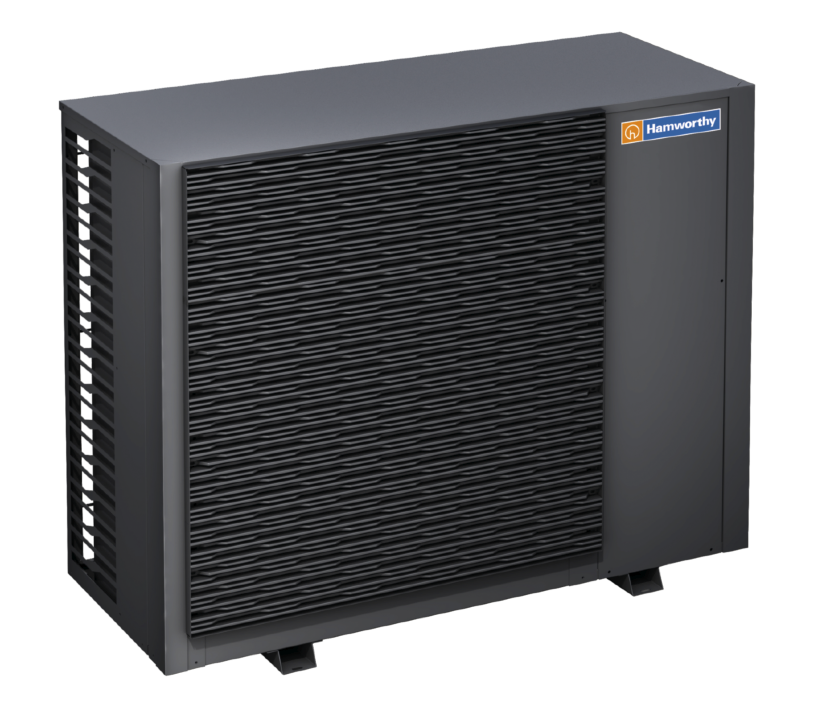Why you need a buffer tank when installing a heat pump
When considering the installation of a commercial air source heat pump, particularly in commercial properties with variable heating demands, an important question arises: is a buffer tank on the primary system necessary? This latest ASK Hamworthy article will explore the role of a buffer tank in a heat pump system, its benefits, and when it becomes essential to ensure optimal performance and longevity.
What is a buffer tank?
A buffer tank is a water vessel that integrates with a heating system to stabilise its operation. It is different from a thermal store which stores excess heat for reuse, or hot water cylinder and instead, stores heated water to manage the temperature, volume and flow in the heating system. Buffer tanks also differ from hot water cylinders and instead are often used alongside them.
The role of the buffer tank is to maintain a minimum volume of water within the system, to help prevent short cycling – where the heat pump frequently turns on and off due to low heating loads compared to the energy generated. Additionally, it provides a bypass route to maintain the minimum flow rate and store warm water required by the heat pump for defrosting during colder snaps.
By absorbing excess thermal energy, the buffer tank ensures consistent system performance, making it an integral part of a well-functioning heat pump setup.

Benefits of installing a buffer tank
Enhanced system efficiency
Buffer tanks prevent the heat pump from starting and stopping frequently, particularly in spring and autumn when the weather is more changeable. By enabling the heat pump to run at a constant output for longer periods, the system operates more efficiently.
Improved temperature stability
For properties with variable heating or cooling demands, buffer tanks retain surplus energy during low demand and release it when demand increases. This reduces temperature fluctuations, ensuring a consistent and comfortable indoor environment.
Protection for your heat pump
Frequent on/off cycling wears out the heat pump, potentially leading to increased maintenance needs and a shorter lifespan. A buffer tank reduces these cycles, extending the heat pump's longevity and lowering repair costs.
Enhanced system control
Buffer tanks provide thermal mass, which slows the rate of temperature changes within the water. This simplifies system control, allowing for better and more accurate management of temperature fluctuations and heat pump performance.
Assistance during defrost cycles
During the heat pump's defrost cycle, heat from the buffer tank can prevent the system from drawing energy from the radiators, ensuring efficient operation without compromising indoor comfort.
When is a buffer tank essential?
Systems with low thermal mass Low thermal mass systems, such as those with small radiators or underfloor heating, have less water in the system to absorb heat, leading to frequent short cycling. A buffer tank adds water volume, stabilizing the system and improving efficiency. It is crucial, however, that the system is sized in accordance with the manufacturer's installation manual to ensure optimal performance and compatibility.
Buildings with fluctuating heat demands Heat pumps are most efficient when operating at steady output. In properties with varying heating needs, a buffer tank stores excess heat during periods of low demand and supplies it during peak periods. This minimises on-off cycling, reduces strain on the heat pump, and ensures a more efficient operation, especially in multi-zone heating systems where buffer tanks reduce the need to adjust the heat pump’s output.
Are buffer tanks always needed? Whilst in domestic settings, some heat pumps are able to adjust their output to match demand, buffer tanks are essential for commercial heat pumps to maintain the necessary water volume. This ensures the system operates efficiently on a larger scale, offering clear advantages that are not always required in domestic settings.

Considerations for installing a buffer tank
Sizing
The buffer tank's size is critical and should be carefully determined based on the specific requirements of the system. While a general guideline suggests 10 litres per kilowatt (kW) of heat pump capacity (e.g., a 10kW heat pump would require a 100-litre buffer tank), this is not always applicable, particularly with systems using refrigerants like R290. Sizing is crucial because an incorrectly sized buffer tank can lead to inefficiencies, such as frequent cycling or inadequate thermal storage.
To ensure accurate sizing, reference the CIBSE sizing methodology or specific manufacturer guidelines. This approach accounts for factors like system design, refrigerant type, and operational dynamics, to ensure the best performance.
Placement
For maximum efficiency, the buffer tank should be installed between the flow and return of the heating system and positioned close to the heat pump to minimise heat loss and make it easier to maintain.
Cost
Although buffer tanks increase upfront installation costs, they protect the heat pump from overworking, reducing the risk of expensive repairs or replacements. Over time, this makes them a cost-effective investment.
Navigate the buffer tank selection process with Hamworthy
A buffer tank plays a crucial role in ensuring the efficiency, stability, and longevity of a heat pump system, particularly in buildings with variable heating demands or systems with low thermal mass.
While not always essential, a buffer tank can significantly enhance performance, protect your investment, and provide long-term savings. By considering factors like system requirements and proper sizing, you can make an informed decision that ensures the success of your heat pump installation.
Hamworthy Heating works with commercial consultants and specifiers to help them find the right solution for their energy-efficient and low carbon heating solutions for their commercial projects. Whether that’s support with technical information, or with the latest hot water technology for a buffer tank setup, the Hamworthy Heating specification team can help you find the right product for your project’s needs.
For more information on how a buffer tank system might be suitable for your project, get in touch with your Area Sales Manager.
Want to learn more? Join us for our upcoming CPD on ‘Air Source Heat Pump Selection, Specification and Design’, or explore Hamworthy Heating’s full range of CPDs!
Considering funding for your low carbon heating project? Have a look at our ASK Hamworthy article on what funding is available in commercial buildings.










